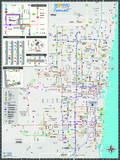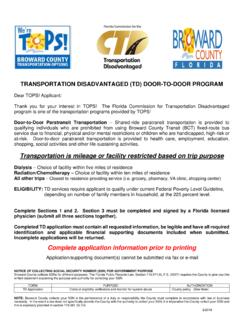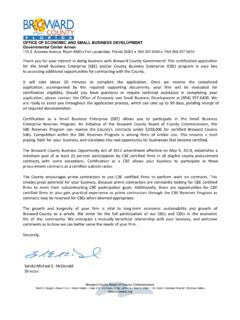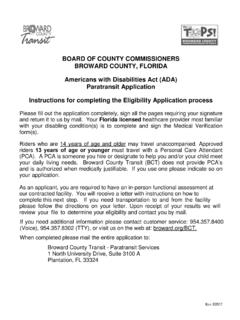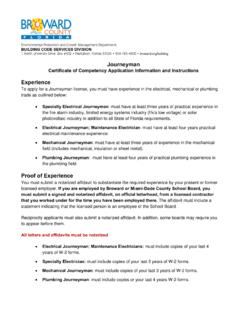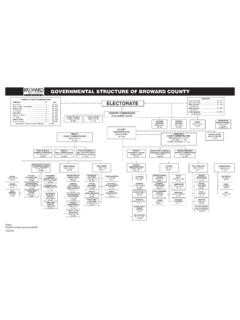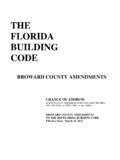Transcription of 10 States Standards - Recommended Standards for …
1 10 States Standards - Recommended Standards for Wastewater Facilities Table of Contents Recommended Standards for Wastewater Facilities 2004 Edition Policies for the Design, Review, and Approval of Plans and Specifications for Wastewater Collection and Treatment Facilities A Report of the Wastewater Committee of the Great Lakes--Upper Mississippi River Board of State and Provincial Public Health and Environmental Managers MEMBER States AND PROVINCE. Illinois Indiana Iowa Michigan Minnesota Missouri New York Ohio Ontario Pennsylvania Wisconsin Published by: Health Research Inc., Health Education Services Division, Box 7126, Albany, NY 12224. (518)439-7286 Copyright 2004 by the Great Lakes - Upper Mississippi River Board of State and Provincial Public Health and Environmental Managers This book, or portions thereof, may be reproduced without permission from the author if proper credit is given. TABLE OF CONTENTS. file:///E|/10%20 States %20 Standards %20-%20 Recommended %20 Standards %20for%20 Wastewater% (1 of 102)10/16/2008 12:43:40 PM.
2 10 States Standards - Recommended Standards for Wastewater Facilities FOREWORD. 10 ENGINEERING REPORTS AND FACILITY PLANS. 10. General 11. Engineering Report Or Facility Plan 20 ENGINEERING PLANS AND SPECIFICATIONS. 20. Plans And Support Documents 21. Specifications 22. Revisions To Approved Plans 30 DESIGN OF SEWERS. 31. Approval Of Sewers 32. Design Capacity And Design Flow 33. Details Of Design And Construction 34. Manholes 35. Inverted Siphons 36. Sewers In Relation To Streams 37. Aerial Crossings 38. Protection Of Water Supplies 40 WASTEWATER PUMPING STATIONS. 41 General 42 Design 43 Suction-Lift Pump Stations 44 Submersible Pump Stations - Special Considerations 45 Screw Pump Stations - Special Considerations 46 Alarm Systems 47 Emergency Operation 48 Instructions And Equipment 49 Force Mains 50 WASTEWATER TREATMENT FACILITIES. 51. Plant Location 52. Quality Of Effluent 53. Design 54. Plant Details 55. Plant Outfalls 56. Essential Facilities 57. Safety 58. Laboratory 60 SCREENING, GRIT REMOVAL, AND FLOW EQUALIZATION.
3 61. Screening Devices file:///E|/10%20 States %20 Standards %20-%20 Recommended %20 Standards %20for%20 Wastewater% (2 of 102)10/16/2008 12:43:40 PM. 10 States Standards - Recommended Standards for Wastewater Facilities 62. Comminutors 63 Grit Removal Facilities 64. Preaeration 65. Flow Equalization 70 SETTLING. 71. General 72. Design Considerations 73. Sludge And Scum Removal 74. Protective And Service Facilities 80 SLUDGE PROCESSING, STORAGE, AND DISPOSAL. 81. General 82. Process Selection 83. Sludge Thickeners 84. Anaerobic Sludge Digestion 85. Aerobic Sludge Digestion 86. High pH Stabilization 87. Sludge Pumps And Piping 88. Sludge Dewatering 89. Sludge Storage And Disposal 90 BIOLOGICAL TREATMENT. 91. Trickling Filters 92. Activated Sludge 93. Wastewater Treatment Ponds 94. Other Biological Systems 100 DISINFECTION. 101. General 102. Chlorine Disinfection 103. Dechlorination 104. Ultraviolet Radiation Disinfection 105. Ozone 110 SUPPLEMENTAL TREATMENT PROCESSES. 111. Phosphorus Removal By Chemical Treatment 112.
4 High Rate Effluent Filtration APPENDIX HANDLING AND TREATMENT OF SEPTAGE AT A WASTEWATER TREATMENT PLANT. FOREWORD. In 1947, a "Committee on Development of Uniform Standards for Sewage Works" was created by the group now known as the Great Lakes -- Upper Mississippi River Board of State and Provincial Public Health and Environmental Managers. This Committee, composed of a representative from each state, was assigned the responsibility to review existing Standards for file:///E|/10%20 States %20 Standards %20-%20 Recommended %20 Standards %20for%20 Wastewater% (3 of 102)10/16/2008 12:43:40 PM. 10 States Standards - Recommended Standards for Wastewater Facilities sewage works, to investigate the possibility of preparing joint Standards to be adopted by the States represented, and to report its findings to the Board. Based on this initial report, the Board authorized the Committee to prepare sewage works design Standards , which were first published in 1951. They subsequently were revised and published again in 1960, 1968, 1971, 1973, 1978, 1990 and 1997.
5 In 1977, the Province of Ontario was invited, as a Great Lakes participant, to serve on the Committee. These Standards have again been revised and are published herein as the 2004 edition. They are intended for use as a guide in the design and preparation of plans and specifications for wastewater facilities insofar as these Standards are applicable to normal situations for an individual project. The design criteria in these Standards are intended for the more conventional municipal wastewater collection and treatment systems. Innovative approaches to collection and treatment, particularly for the very small municipal systems, are not included. The individual reviewing authority should be contacted for design guidance and criteria where such systems are being considered. Lack of description or criteria for a unit process or equipment does not suggest it should not be used, but only that consideration by the reviewing authority will be on the basis of information submitted with the design.
6 Engineering data that may be required for new process and application evaluation is included in Paragraph of these Standards . These Standards are intended to suggest limiting values for items upon which an evaluation of the plans and specifications will be made by the reviewing authority; and to establish, as far as practicable, uniformity of practice among the several States and province. Statutory requirements, regulations, and guidelines among the States and province are not uniform and use of the Standards must adjust itself to these variations. Users also should be cognizant of locally adopted Standards and applicable federal requirements. The term "shall" is used where practice is sufficiently standardized to permit specific delineation of requirements or where safeguarding of the public health or protection of water quality justifies such definite action. Other terms, such as "should,". " Recommended ," and "preferred," indicate desirable procedures or methods, with deviations subject to individual consideration.
7 Definition of terms and their use in these Standards is intended to be in accordance with GLOSSARY -- WATER AND. WASTEWATER CONTROL ENGINEERING, jointly prepared by APHA, ASCE, AWWA, and WPCF. The customary units of expression used are in accordance with those Recommended in WPCF Manual of Practice No. 6, UNITS OF EXPRESSION FOR. WASTEWATER MANAGEMENT. The International Standard Units are in accordance with those Recommended in National Institute of Standards and Technology (NIST) Guide for the Use of the International System of Units (SI). CHAPTER 10. ENGINEERING REPORTS AND FACILITY PLANS. 10. GENERAL. Engineering Services Engineering services are performed in three steps: a. Engineering Report or Facility Plan;. b. Preparation of construction plans, specifications, and contractual documents; and c. Construction compliance, inspection, administration, and acceptance. Chapter 10, Engineering Reports and Facility Plans, covers only item a. above. Preliminary Project Submittal A preliminary project submittal may be necessary prior to preparation of an Engineering Report or Facility Plan.
8 This submittal needs to include: a. A description of problems or developments which have resulted in consideration of a wastewater facilities project;. b. Identification of governmental and consultant representatives authorized to provide information and seek regulatory agency approvals and decisions regarding the project; and file:///E|/10%20 States %20 Standards %20-%20 Recommended %20 Standards %20for%20 Wastewater% (4 of 102)10/16/2008 12:43:40 PM. 10 States Standards - Recommended Standards for Wastewater Facilities c. Identification of potential treated wastewater discharge locations for the purpose of regulatory agency determinations of suitable effluent quality requirements. No approval for construction can be issued until final, detailed plans and specifications have been submitted and approved by the appropriate reviewing authority. Refer to Chapter 20. 11. ENGINEERING REPORT OR FACILITY PLAN. For federal, provincial, or state financed grant or loan projects, additional requirements may apply.
9 The Engineering Report or Facility Plan: identifies and evaluates wastewater related problems; assembles basic information; presents criteria and assumptions; examines alternate projects, with preliminary layouts and cost estimates;. describes financing methods, sets forth anticipated charges for users; reviews organizational and staffing requirements;. offers a conclusion with a proposed project for client consideration; and outlines official actions and procedures to implement the project. The planning document must include sufficient detail to demonstrate that the proposed project meets applicable criteria. The concept (including process description and sizing), factual data, and controlling assumptions and considerations for the functional planning of wastewater facilities are presented for each process unit and for the whole system. These data form the continuing technical basis for the detailed design and preparation of construction plans and specifications. Architectural, structural, mechanical, and electrical designs are usually excluded.
10 Sketches may be desirable to aid in presentation of a project. Outline specifications of process units, special equipment, etc., are occasionally included. Engineering Reports must be completed for minor collection system, pump station, and interceptor projects. Comprehensive Facility Plans must be completed or have been completed for projects involving new, expanded, upgraded, or rehabilitated wastewater treatment facilities and major collection, interceptor sewer , and pump station projects. The determination of classification as major or minor collection interceptor sewer and pump station projects will be made by the reviewing authority based on review of Recommended classification by the owner. Engineering Reports Engineering reports shall contain the following and other pertinent information as required by the reviewing authority: Problem Defined Description of the existing system should include an evaluation of the conditions and problems needing correction. Flow and Organic Load The anticipated design average and design peak flows and waste load for the existing and ultimate conditions must be established.
